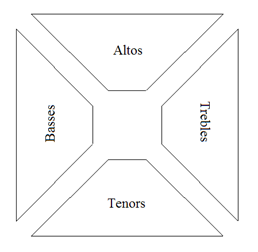[The views expressed in this blog are from my personal experiences from 25 years of leading non-auditioned community choirs in the UK, as well as adult singing workshops. My focus is on teaching by ear using a repertoire of songs from traditions across the globe. Your experiences may differ from mine, so do feel free to leave a comment and let's begin a conversation! A version of this article first appeared as a post on my blog From the Front of the Choir]
Many singing groups work in a circle when learning and rehearsing songs.

There are some advantages, but also downsides. Let’s look at the pros and cons.
Singing groups and small choirs often work in a circle. It seems a natural way for a smallish group of singers to stand: you can see and hear everyone clearly. But it doesn’t work for all groups and has a few downsides too.
Here are some advantages and disadvantages of singing in a circle.
advantages
- every singer can see and hear every other singer clearly
- there is a single row so each singer has only the two singers either side to rely on – they’ll need to take more responsibility for learning their part
- every singer can see the choir leader easily
- there is no sense of hierarchy
- every part is next to two other parts, no part is on the end – allows the harmonies to be heard more clearly
- the choir leader can see and make eye contact with every singer easily – there is nowhere to hide!
- it is easier to move singers around without disrupting the overall structure
- you can dance more easily if required!
disadvantages
- with big groups, the circle can become large and unmanageable – the choir leader will have to shout to be heard and singers on opposite sides of the circle won’t be able to hear each other
- it’s easy for the choir leader to end up addressing one half of the circle without realising those behind her can’t see or hear what she’s saying
- having got used to singing in a circle, the transition to a different choir formation for performance might throw up a few wobbles
- newer singers won’t have the benefit of more experienced singers in their part singing from behind them to reinforce them (see Why you should stand front and centre if you’re not a confident singer)
- if your choir is not used to singing in a circle, your singers might feel very exposed at first (although it won’t take long to overcome this)
- singing regularly in a circle can become too inward: singers begin to forget that they will be communicating outwards to an audience when they come to perform
- it’s harder for a choir leader to conduct in a circle as they need to keep turning on the spot (however, being in a circle is a great way for singers to learn to work without a conductor and to really focus on each other)
other possibilities
The other, most common, way to rehearse is to stand in the configuration that you usually perform in (see STAB, TABS or ASSBAT – how does your choir line up?).
In order to make sure I had equal numbers of singers in each part (I encourage people to move parts in my choirs), I once spent a term rehearsing in a square.
This is similar to the hollow square used by to shape note singers. An equal number of singers in each of the four parts form a square shape with a small gap between parts. Other singers from each part line up behind so it looks something like this:

I’d love to hear from you if you’ve tried singing in a circle or have other interesting ways of positioning your singers when rehearsing.
… found this helpful?
I provide this content free of charge, because I like to be helpful. If you have found it useful, you may like to
 to say thank you.
to say thank you.
To get more posts like this delivered straight to your inbox,
click to subscribe by email.
Chris Rowbury
website: chrisrowbury.com
blog: blog.chrisrowbury.com
Facebook: Facebook.com/ChrisRowbury
Twitter: Twitter.com/ChrisRowbury
Monthly Music Roundup: Tinyletter.com/ChrisRowbury
YouTube: YouTube.com/ChrisRowbury